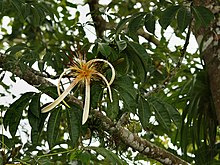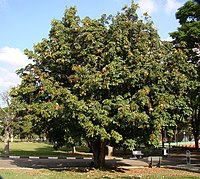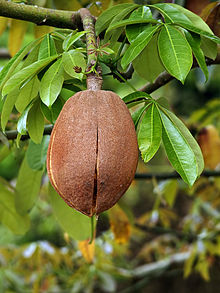
The chestnuts are the deciduous trees and shrubs in the genus Castanea, in the beech family Fagaceae. The name also refers to the edible nuts they produce. They are native to temperate regions of the Northern Hemisphere.

Melicoccus bijugatus is a fruit-bearing tree in the soapberry family Sapindaceae, native or naturalized across the New World tropics including South and Central America, and parts of the Caribbean. Its stone-bearing fruits, commonly called quenepa or guinep, are edible. These fruits have various other names such as Bajan ackee, Spanish lime or mamoncillo, among numerous other common names.

The jackfruit is the fruit of jack treeArtocarpus heterophyllus, a species of tree in the fig, mulberry, and breadfruit family (Moraceae). The jackfruit is the largest tree fruit, reaching as much as 55 kg in weight, 90 cm in length, and 50 cm in diameter. A mature jackfruit tree produces some 200 fruits per year, with older trees bearing up to 500 fruits in a year. The jackfruit is a multiple fruit composed of hundreds to thousands of individual flowers, and the fleshy petals of the unripe fruit are eaten.

Castanea sativa, the sweet chestnut, Spanish chestnut or just chestnut, is a species of tree in the family Fagaceae, native to Southern Europe and Asia Minor, and widely cultivated throughout the temperate world. A substantial, long-lived deciduous tree, it produces an edible seed, the chestnut, which has been used in cooking since ancient times.

Hoya is a genus of over 500 accepted species of tropical plants in the dogbane family, Apocynaceae. Most are native to several countries of Asia such as the Philippines, India, Thailand, Malaysia, Vietnam, Bangladesh, Indonesia, Polynesia, New Guinea, and many species are also found in Australia.

Monstera deliciosa, the Swiss cheese plant or split-leaf philodendron is a species of flowering plant native to tropical forests of southern Mexico, south to Panama. It has been introduced to many tropical areas, and has become a mildly invasive species in Hawaii, Seychelles, Ascension Island and the Society Islands. It is very widely grown in temperate zones as a houseplant.

Bombax is a genus of mainly tropical trees in the mallow family. They are native to western Africa, the Indian subcontinent, Southeast Asia, and the subtropical regions of East Asia and northern Australia. It is distinguished from the genus Ceiba, which has whiter flowers.

Chlorophytum comosum, usually called spider plant or common spider plant due to its spider-like look, also known as spider ivy, airplane plant, ribbon plant, and hen and chickens is a species of evergreen perennial flowering plant of the family Asparagaceae. It is native to tropical and Southern Africa but has become naturalized in other parts of the world, including Western Australia and Bangladesh. Chlorophytum comosum is easy to grow as a houseplant because of its resilience, but it can be sensitive to the fluoride in tap water, which commonly gives it "burnt tips". Variegated forms are the most popular.
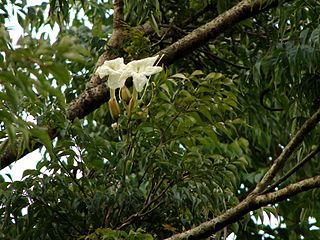
Radermachera sinica, also called china doll, serpent tree or emerald tree, is an evergreen tree in the family Bignoniaceae, native to the subtropical mountain regions of southern China and Taiwan.

Aesculus californica, commonly known as the California buckeye or California horse-chestnut, is a species of buckeye native to California and southwestern Oregon.

Lagerstroemia speciosa is a species of Lagerstroemia native to tropical southern Asia. It is a deciduous tree with bright pink to light purple flowers.

Castanea crenata, the Japanese chestnut or Korean chestnut, is a species of chestnut native to Japan and Korea. Castanea crenata exhibits resistance to Phytophthora cinnamomi, the fungal pathogen that causes ink disease in several Castanea species. The mechanism of resistance of Castanea crenata to Phytophthora cinnamomi may derive from its expression of the Cast_Gnk2-like gene.

Castanea pumila, commonly known as the Allegheny chinquapin, American chinquapin or dwarf chestnut, is a species of chestnut native to the southeastern United States. The native range is from Massachusetts and New York to Maryland and extreme southern New Jersey and southeast Pennsylvania south to central Florida, west to eastern Texas, and north to southern Missouri and Kentucky. The plant's habitat is dry sandy and rocky uplands and ridges mixed with oak and hickory to 1000 m elevation. It grows best on well-drained soils in full sun or partial shade.

Hicksbeachia pinnatifolia is a small tree in the family Proteaceae. This rare species is native to subtropical rainforest in New South Wales and Queensland in Australia. Common names include red bopple nut, monkey nut, red nut, beef nut, rose nut and ivory silky oak. The tree produces fleshy, red fruits during spring and summer. These contain edible seeds.

Pachira is a genus of tropical trees distributed in Central and South America, Africa and India. They are classified in the subfamily Bombacoideae of the family Malvaceae. Previously the genus was assigned to Bombacaceae. Prior to that the genus was found in the Sterculiaceae.
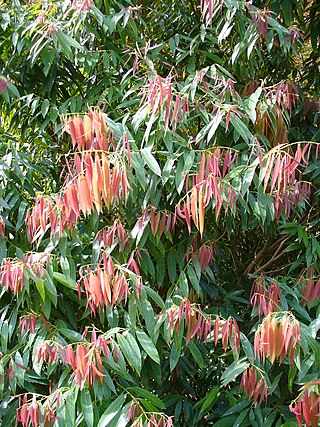
Nagkesar oil is extracted from seeds of the nagkesar tree. It belongs to the Calophyllaceae family. It is an East Indian evergreen tree and is often planted as an ornamental for its fragrant white flowers that yield a perfume. It is the source of hardwood used for railroad ties. It is Sri Lanka's national tree.

Sterculia foetida is a soft wooded tree that can grow up to 35 metres tall. Common names for the plant are the bastard poon tree, Java olive tree, hazel sterculia, wild almond tree, and skunk tree.

Crassula ovata, commonly known as jade plant, lucky plant, money plant or money tree, is a succulent plant with small pink or white flowers that is native to the KwaZulu-Natal and Eastern Cape provinces of South Africa, and Mozambique; it is common as a houseplant worldwide. Much of its popularity stems from the low levels of care needed; the jade plant requires little water and can survive in most indoor conditions. It is sometimes referred to as the money tree; however, Pachira aquatica also has this nickname.

Pachira glabra is a tropical wetland tree in the mallow family Malvaceae, native to eastern Brazil, where it grows along rivers and other waterways. It is generally known by the nonscientific names Guinea peanut, French peanut, Saba nut, money tree, and lucky tree. It shares many of these common names with Pachira aquatica, the Malabar chestnut, which is quite similar looking, has similar culinary and ornamental uses, and is often confused with P. glabra.
